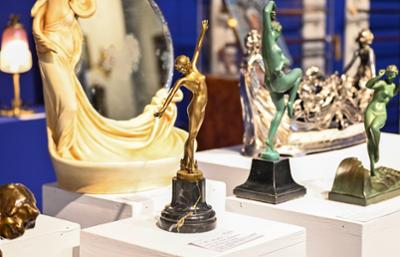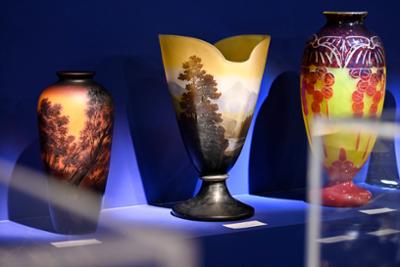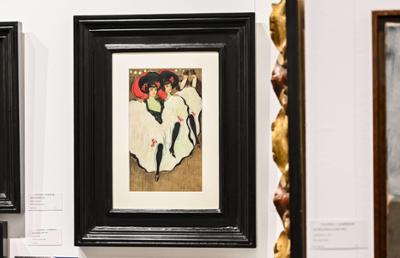

What is Art Nouveau, artists and artworks
Discover the artistic language of beauty through Art Nouveau and get to know its most outstanding artists and works.
The second half of the 19th century, especially from the so-called Belle Époque [1971-1914], was characterised by a desire for aesthetic renewal of the traditional arts, with artists seeking creative freedom and a break with the ways of the past.
In contrast to the "artificial" models of historicism and academicism, Art Nouveau was also born as a reaction against industrial mass production and an exacerbated search for beauty in all aspects of life, inheriting, in turn, the considerations of Symbolism, the theoretical approaches of John Ruskin and William Morris and the morphologies of nature as a source of symbols and splendour.
Art Nouveau, in general terms, conceived the work of art as a whole in which all artistic manifestations, from painting and sculpture to the decorative arts and fashion, were included in the development of an equally renewed architecture. It is an essentially ornamental style, adding various hedonistic elements to useful objects in a perfect union between functionality and ornamentation, between the utilitarian and the beautiful.
The dissemination of the styles, trends and essential characteristics of Art Nouveau took place through art and fashion magazines, as well as through universal and international exhibitions (such as the International Exhibition of Decorative Arts in Turin in 1902) and the development of commerce and its advertising apparatus through the poster. Art Nouveau will be given different names and typologies, with its own unique characteristics, depending on the country and the spatial and historical context in which it develops. Thus, we find the development of Art Nouveau in Belgium and France, Art Nouveau in Spain, Viennese Secession in Vienna, Modern Style in the United Kingdom or Jugendstil in Germany and the Nordic countries.
Regardless of the variations of time and place, Art Nouveau had a number of constant characteristics: a taste for nature (especially floral and animal motifs), the use of iconic motifs from Japanese art (in connection with the development of Japonisme in Europe), morphology and a taste for curved rhythms and their variants (spirals, scrolls, etc.) and cool, faint or transparent colours in flat or veined, iridescent or shaded materials. All this converges in a search for musical, undulating and sinuous rhythms with the aim of communicating lightness, youth and optimism in the face of a renewed society.
The Architectural Language of Art Nouveau
Following the social, cultural and political renewal brought about by the outbreak of the Industrial Revolution in the old European capitals of the second half of the 19th century, the way of looking at architecture evolved with increasing intensity towards new forms far removed from Gothic and neo-Historicist principles. This new art of the second half looked to the future and to the creative possibilities afforded by the use of new materials hitherto unused: cast iron and steel.
The insistent search of theoreticians and architects such as Viollet-le-duc for the development of new forms that would overcome the architectural limitations of the styles of the past materialised through figures such as Victor Horta, considered the first architect to successfully adapt the modernist language of the new architecture, the so-called Art Nouveau. Others did the same in their respective countries, such as Otto Wagner in Austria, or Antonio Gaudí in Spain.
This new architecture, both public and private, produced by these architects moved away from the coldness of industrial trends, concealing the framework of their buildings through a renewed, colourful, iridescent and naturalistic decoration, allowing their residents and owners - generally belonging to the upper financial bourgeoisie - to escape from the bustle of increasingly bustling and crowded cities. The modernist architect sought and longed to build a living city, faithful to a positivist society that felt its control over nature and to a bourgeoisie that placed great faith in the idea of progress and the economic and business development of the country and whose architecture should also reflect this.
Main artists and works
In addition to architecture, this innovative style found expression in all known artistic practices. Art Nouveau painters sought to capture the ephemeral and fantastic that they discovered in the beauty of the natural world, creating compositions full of complex sensations, sonorities and symbolism through colour and line. They also depicted emotional, vitalistic or even erotic scenes from everyday life or timeless myths.
Czech-born Alphonse Mucha [1860-1939] was one of the most influential and recognised figures of Art Nouveau throughout Europe. Characterised by his sinuous lines, vital female representations and intricate motifs, his most emblematic works are to be found in his graphic production in the form of posters, such as those created for the actress Sarah Bernhardt for various plays such as Gismonda [1894-95], Hamlet [1899] and Medea [1898]. He was also outstanding for his decorative panels, where he conceived famous series such as The Arts [1898], The Flowers [1898] and The Seasons [1896], where the elegance and ideal beauty of the style are personified with such mastery that they transcend the values of his own time.
Mucha's work inspired numerous artists who took the figures he depicted in his posters and panels as models. An example of this can be found in the sculptural work of Emmanuel Villanis [1858-1914], in the form of bronze busts of women such as Selika and La Sybille; the brothers Hippolyte François Moreau [1832-1927] and Auguste Moreau [1834-1917] and Auguste Seysses [1862-1946], who worked hand in hand with the artist to create sculptures of female figures based on his pictorial models in marble and bronze, including his collaboration in Femme aux lys [1901-02] at the Musee d'Orsay in Paris.
However, the purest expression of the language of Art Nouveau was to be found in the decorative arts, through small useful objects such as vases, glasses, jewellery, lamps and all kinds of furniture, which were decorated with the forms of female, natural and animal figures, including butterflies, dragonflies and cicadas and natural figures. Many of these pieces, in keeping with the sinuous lines of this language of beauty, were set with diamonds, sapphires and chrysoberyls, among other gems. The mastery of Émile Gallé [1846-1904], who was of interest to the art market, and the École de Nancy, which specialised in the technique of glass, played a key role in this.
Art Nouveau in Spain
In Spain, the influence of Art Nouveau materialised in its own right in what came to be known as Modernisme, especially in Catalonia through the grouping of various artists around the magazine L'Avenç [1881-93], in which the figure of Santiago Rusiñol [1861-1931], whose artistic training took place in both Barcelona and Paris, stood out. His training in both places enabled him to conceive a language of his own in which landscape, as in his series of the gardens of Aranjuez, or the portrait of the Catalan and French bourgeoisie and bohemian life, as in Café de los Incoherentes [1890] and Grand Bal [1891], stand out.
He was joined by Ramón Casas [1866-1932], who became a social phenomenon of the day as the leading portraitist of the Catalan gentry and, in particular, of various female figures such as Madeleine de Boisguillaume in Au Molin de la Galette [1892] and Julia Pereira [c. 1915], in which he broke with the prototype of the woman in her role of temptress inherited from the figurative tradition of Eve, presenting urban, independent, free and modern women. The Catalan modernist circle was complemented by other figures such as Hermenegildo Anglada Camarasa [1871-1959], in whose work the decorative element is pushed to its furthest limits, Joan Cardona [1877-1958] and Joan Llimona [1860-1926], among others.
Although the Art Nouveau period was a relatively brief period, its inspirational impact on later artists and admirers has endured to the present day, bearing witness to the creative possibilities that are born when art, nature and aesthetics converge in harmony.
Daniel Alvarado Santiago







